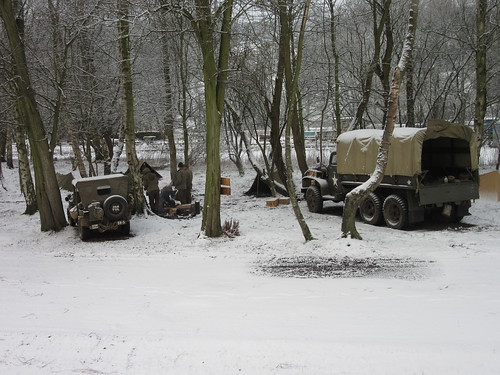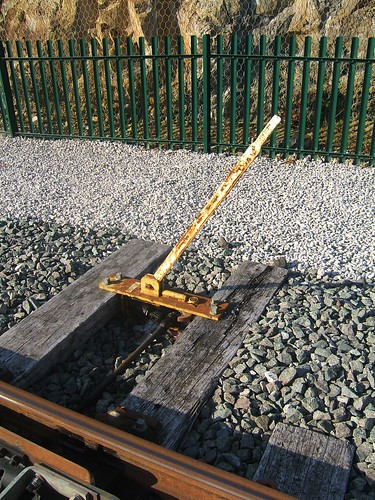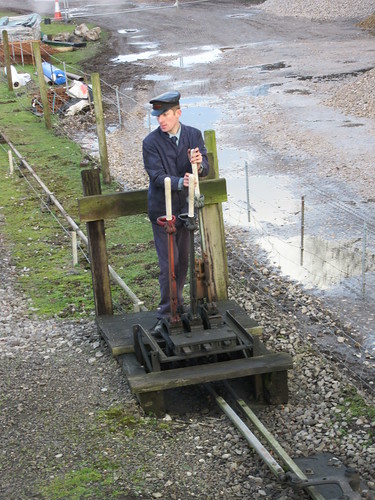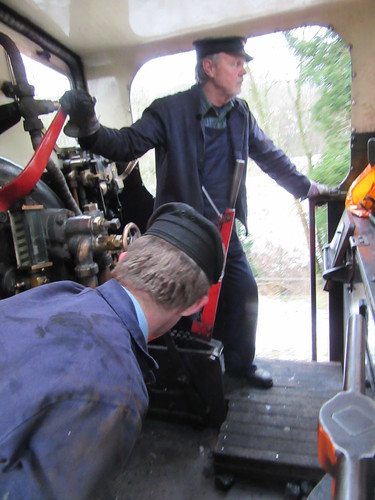The winter timetable was first introduced at the end of 2013, as I described in the posts Winter Timetable at Peak Rail and Peak Rail in early 2014.
A year later, in early 2015, I operated the winter timetable on a couple of days, as described in the post Rain, Sleet and Snow.
Events of 17th January 2016
It was snowing at home when I got up and it continued to snow on the journey. By the time I reached Peak Rail, the snow had stopped but everywhere was white over.
 Peak Rail in the Snow.
Peak Rail in the Snow.
Mike S. the fireman and Jacob S. the cleaner reported nothing frozen up and, since the locomotive had been in use the day before, the locomotive was starting to steam. So, we didn't seem to have too much to complain about. I like to view our footplate work as a tribute to the real professionals who ran the nation's steam railways under almost unimaginable conditions in the past. In the post Rain, Sleet and Snow, in referring to an earlier trip under adverse conditions described here, I quote one of my sayings "Anyone can work on the footplate in good weather. It takes an engineman to do it in bad weather."
But I had to admire a group of military re-enactors who had spent the previous night in bivouac within the trees, with only small, canvas tents for shelter. As I arrived, they were just getting up and preparing a simple breakfast.
 Peak Rail in the Snow: A group of military re-enactors after a night in tents.
Peak Rail in the Snow: A group of military re-enactors after a night in tents.
After a number of years as a fireman, Mike S. had just started training to pass out for driving so I encouraged him to do most of the oiling-round and daily examination. It's important to be methodical, so as not to omit oiling points but the driver should try to keep an open mind during examination, looking for anything out of the ordinary, not just checking items by rote. Time spent at this stage will give the driver confidence that he can carry out the booked working without interruption.
Before working the service train, we had a one hour driving experience course booked so we came 'off shed' as early as possible to move across to the platform where we would pick up our trainee driver. The snow could affect both adhesion and braking but the locomotive was handling fairly normally. To reach the platform, we had to change a number of sets of points. Changing points ('knobbing up' is a common railway slang term) involves moving one switch rail away from the stock (fixed) rail and moving the other switch rail so as to fit tightly against the other stock rail. The two switch rails are tied together by a 'point stretcher' so both switch rails are moved at once. We didn't have icing conditions so the first operation, moving one switch rail away from the stock rail was fine, simply pushing loose snow out of the way. The second operation involves squeezing a switch rail against the stock rail which, when there's snow, usually compacts snow against the stock rail preventing the switch rail from 'fitting up' properly unless snow is first cleared away from the area involved.
The first two sets of points we changed were locally operated 'Hand points'.

Typical point lever for Hand Points (at Matlock Town on Peak Rail).
Next, we had to 'reverse' the crossover leading to the single line which is operated from a Ground Frame released by the Single Line Token, move the locomotive onto the single line, replace the crossover to 'normal', retrieve the token and move down to the platform.

Jacob operating the South Ground Frame at Rowsley (on a day without snow!).
With all the snow clearing involved, it took a lot longer to complete the light engine move from the shed to the station than normal.
Apart from the safety issues of moving around on the ground in the snow, there are always important safety considerations when working near points - it's vital nobody has a hand or foot in the way when there's a chance somebody will attempt to operate them. With hand points, the lever is close by but with ground frames the lever may be some yards away, increasing the risk. Where points are operated from a signal box, the lever may be hundreds of yards away or, with power operation, miles away. Safety is achieved only by coming to a clear understanding with the person controlling the points before starting any work. There's a bit more information about British railway signalling in a series of posts starting here. In this series, Part 6 covers Mechanical Operation of Points.
We spent the next hour showing our driving experience candidate how to drive and fire a small locomotive.
The rest of the day was spent running four round trips to Matlock Riverside. I drove the first and last trips and let Mike drive the other two. Becoming a competent driver requires practice (and, I always say, 'fierce concentration').

Returning to Rowsley bunker-first, with Mike driving and Jacob firing.
At the end of traffic, we took 'Lord Phil' back to shed for disposal after an enjoyable day.
Events of 24th January 2016
A week later, I was back at Peak Rail, this time without snow and with Phil M. as fireman. After a number of years as a fireman, Phil M. had also just started training to pass out for driving so I suggested that he did most of the oiling-round and locomotive examination whilst I assisted and provided hopefully helpful comments. Once again, we started with a 1-hour driving experience course which our trainee greatly enjoyed (as they usually do). I drove the first service train, let Phil drive the second and third, then I drove the last train before we came on shed to dispose. Another good day!
My pictures
Peak Rail in the Snow
